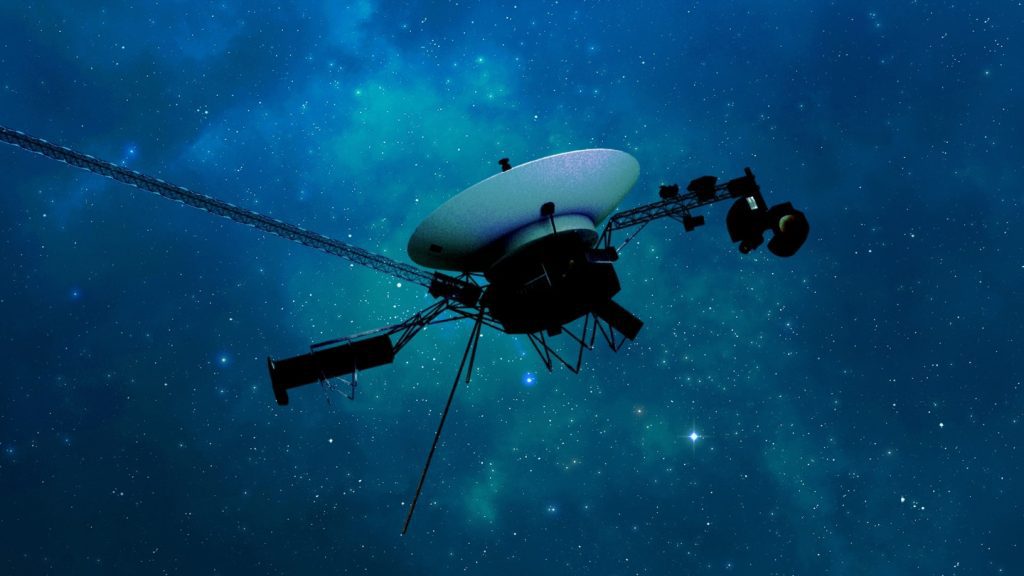Voyager 1 has overcome months of difficult problem-solving and anxious waiting and is now communicating with Earth again.
The aging NASA spacecraft, located about 24 billion kilometers from home, started sending unclear data in November. On April 20, NASA scientists successfully re-established connection with the probe by installing new flight software to compensate for a portion of the onboard computer memory that had malfunctioned. They are currently receiving information about the spacecraft’s condition and anticipating to receive communication from its scientific instruments in the coming weeks, explained Suzanne Dodd, the project manager of the mission at NASA’s Jet Propulsion Laboratory in Pasadena, Calif.
This signals that the renowned craft may be on the path to recovery and will be able to continue its exploration of interstellar space.
Launched in 1977, Voyager 1 briefly visited Jupiter and Saturn before leaving the solar system. It, along with its twin Voyager 2, holds the record for the longest operating space probes and is currently focused on studying distant solar particles and cosmic rays. The probes have been specifically observing the changes in the sun’s magnetic field and the density of plasma outside the solar system, providing insights into the farthest regions of the sun’s influence..
Suzanne Dodd commented, “The spacecraft's longevity is truly remarkable. It’s extraordinary. We aim to keep Voyager operational for as long as possible so we can document these changes over time.”
Voyager 1 and 2, traveling along different paths, made history by reaching the heliopause in 2012 and 2018 and 2018, respectively (SN: 9/12/13; SN: 12/10/18). This is considered the outer limit of our star’s magnetic field and the solar wind, the boundary before interstellar space.
Since then, the science team has made some unexpected discoveries (SN: 11/4/19). For example, they’ve concluded that the heliosphere, the large space area influenced by the solar wind, may not be spherical but have one or two tails, resembling a comet or a croissant.
Thanks to Voyager, scientists have learned that, contrary to expectations, the sun’s magnetic field and charged particles continue to be significant even beyond the heliopause, according to David McComas, an astrophysicist at Princeton University who is not part of the mission.
Some theories suggested a calm environment in the distant realms of interstellar space, but the Voyagers keep encountering waves of charged particles, indicating that the solar magnetic field still has influence there. Additionally, the probes' findings have revealed how disturbances in the field create bubbles at the edge of the solar system, which is more turbulent and active than previously thought.
Further missions have begun to expand on Voyager’s research in solar physics, such as NASA’s Interstellar Boundary Explorer (IBEX) and the upcoming Interstellar Mapping and Acceleration Probe (IMAP). IBEX has been surveying high-energy particles to map the heliosphere for 15 years, while IMAP will orbit between the sun and Earth, providing an uninterrupted view of the sun as it monitors galactic cosmic rays that penetrate the heliosphere.
“The connection between the Voyagers and both IBEX and IMAP is very strong,” says McComas, main researcher of the latter two missions. “We were all really worried when Voyager 1 stopped communicating with us.”
It will be many years until another mission could achieve what the Voyagers have done. NASA’s New Horizons flew past Pluto in 2015 and kept moving forward (SN:8/9/18). It’s moving towards the edge of the solar system, but it’s moving slowly and will lose power before it can gather data beyond the heliopause.
The Voyagers can continue flying indefinitely, but the power for their instruments is decreasing. In the next few years, NASA will deactivate some instruments to save energy for the remainder.
This means that Voyager 1’s time for collecting scientific data is limited. “It’s a very cherished mission,” Dodd says. “It’s humanity’s spacecraft, and we have to look after it.”



